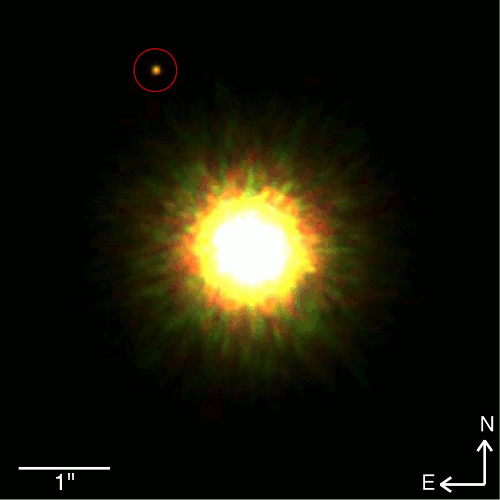Exoplanet hunting takes time, a fact that is well demonstrated in the case of a newly confirmed gas giant. Eight times as massive as Jupiter, it orbits a star much like the Sun but at a distance vast enough (300 AU) to place it well within the Kuiper Belt if it were in our own system. 1RXS 1609 b was first reported back in September of 2008 when David Lafrenière (now at the University of Montreal) and team used adaptive optics to take direct images and spectra of the object, which can be seen in the image below.

Image: First released in September of 2008: Gemini adaptive optics image of 1RXS J160929.1-210524 and its ~8 Jupiter-mass companion (within red circle). This image is a composite of J-, H- and K-band near-infrared images. All images obtained with the Gemini Altair adaptive optics system and the Near-Infrared Imager (NIRI) on the Gemini North telescope. Credit: Gemini Observatory.
This was thought to have been the first planet directly imaged around a Sun-like star, but the question was whether the object was gravitationally associated with the star, something that only time would tell. There was always the possibility that what the astronomers had found was a chance alignment. Says Lafrenière:
“Back in 2008 what we knew for sure was that there was this young planetary mass object sitting right next to a young Sun-like star on the sky. Our new observations rule out this chance alignment possibility, and thus confirm that the planet and the star are related to each other.”
So what do we know about the planet circling 1RXS 1609, other than its mass? For one thing, the team’s subsequent work has shown that there are no additional planets of Jupiter mass or greater in this system, which makes the planet intriguing in terms of planetary formation models. Time again enters into the equation — as we continue observations for several more years, we should be able to learn more about the planet’s orbit, which will take more than 1000 years to complete. A circular orbit would imply formation at a great distance from the host star.
But a non-circular or unbound orbit would tell a different tale, indicating that the planet may have formed close to its star only to become involved in a gravitational encounter with another object that resulted in its being flung into the outer system. We do know that this is a warm place, with an estimated temperature of 1800 Kelvin (1500 degrees Celsius), much hotter than Jupiter. That’s consistent with the young age of the system (roughly five million years). The contraction of the planet under its own gravity, once ended, will let the object cool down by radiating infrared light, but it may not reach Jupiter levels (160 Kelvin in the cloud tops) for several billion years.
Lafrenière notes that his team was able to obtain a spectrum of the object back in 2008, finding absorption features due to water vapor, carbon monoxide and molecular hydrogen in the atmosphere. We’ve found other planets through direct imaging, including the trio orbiting HR 8799 (more massive and five times as luminous as the Sun), but the odd outlier circling 1RXS 1609 provides plenty of fodder for planet formation theorists. From the preprint on this work:
The planetary mass companion 1RXS J1609-2105 b is the least massive known to date with an orbital separation of a few hundreds of AU… [T]he existence of such a low mass companion orbiting so far away from its star poses a great challenge for star and planet formation models. Indeed, all main modes of formation — core accretion, gravitational instability or binary-like formation — and migration — disk interaction or planet-planet interaction — face some obstacles when trying to account for such a companion.
The paper is Lafrenière et al., “The Directly Imaged Planet around the Young Solar Analog 1RXS J160929.1-210524: Confirmation of Common Proper Motion, Temperature and Mass,” accepted by the Astrophysical Journal (preprint).



I recall writers not too many decades ago declaring such observations impossible due to the dimness of the planet swamped by its parent sun’s glare.
This picture brings to mind early telescopic views with the long-focal length single-element refractors. As optics advanced in design in the last few centuries, we will see instruments in space eventually imaging the dimmer exoplanets.
At that planet’s temperature, any close-in moons may be rather “cozy” places despite the 300 AU distance from the star. Perhaps this planet could serve as a “model-testing world” for theories about habitable planets orbiting brown dwarfs?
“but at a distance vast enough (300 AU) to place it well within the Kuiper Belt if it were in our own system.”
I would argue this would place it far outside the Kuiper Belt.
(correct me if I’m wrong, but isn’t the Kuiper Belt from ~30 – 40 AU?)
James is right! Lets start some RV observations on 1RXS 1609’b’, assuming its not too faint, who knows there might be a Mars sized exomoon in there somewhere!
P
Thomas writes:
Good point. I see estimates of the Kuiper Belt going out further than 40 AU, but I was over-enthusiastic in thinking that 300 AU would fit in. The consensus right now seems to be 30 to 60 AU or thereabouts, as best I can determine (and, of course, we have to allow for some eccentric orbits that can push these limits).
Is it possible for a star to be hot enough that a planet of it could still be in the habitable zone while yet also being at the distance required for the planet to be at the gravitational lens point of that star? Denizens of that world would have a head start on grokking the universe with that super-telescopic position.